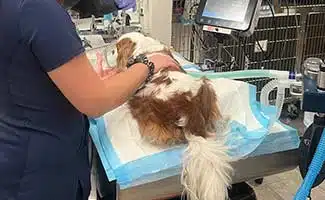
To keep the lights on, we receive affiliate commissions via some of our links. Our review process.

Have you noticed your pup scooting his bottom along the ground or straining when he tries to defecate? Upon closer inspection, does he have a red, inflamed anus or other signs that his rear end doesn’t look right? Because we tend to assume that our dogs get the same ailments as we do, your initial self-diagnosis may be that your pup has hemorrhoids. But can dogs get hemorrhoids? Our pups can suffer from several different anal and rectal problems, so we’ll share details of these conditions and what to do to help your uncomfortable furbaby.
Can Dogs Get Hemorrhoids?
Contents
Human hemorrhoids are swollen blood vessels in the lower rectum or anus. They can occur internally within the rectum or externally, causing the skin around the anus to become inflamed and swollen. How do humans get hemorrhoids? They’re caused by excess pressure on the veins as a result of straining too much during bowel movements with chronic constipation or diarrhea. Literally a pain in the butt, hemorrhoids can range from slightly uncomfortable to extremely painful.
Fortunately, our canine counterparts don’t get hemorrhoids as we do. Why? A dog’s gastrointestinal (GI) anatomy differs from a human’s. Because dogs walk on four legs, their GI system runs horizontally, while a human’s runs vertically. Therefore, dogs’ anal and rectal blood vessels aren’t under the pressure that causes hemorrhoids in humans.
Unfortunately, our pups do suffer from other equally uncomfortable rectal and anal problems that can be misinterpreted as symptoms of dog hemorrhoids. The most common is blocked anal glands, but anal tumors, a prolapsed rectum, and some other conditions can mimic hemorrhoid symptoms.
Signs In Dogs Often Mistaken For Hemorrhoid Symptoms
- Scooting their rear along the floor
- Excessive licking or biting at their rear end
- Anal redness and inflammation
- Difficulty or straining when defecating
- Pain when sitting down
- Anal discharge
- Blood in the feces
Scooting and anal itchiness can also be signs of intestinal parasites. Puppies are particularly prone to worms, so it’s important to ensure you’re following your veterinarian’s puppy deworming schedule to keep your furry friend healthy.
Conditions Confused For Dog Hemorrhoids
If these aren’t symptoms of dog hemorrhoids, then what’s going on with your pup’s bottom issues? Here are some of the most common problems that owners can mistake for dog hemorrhoids.
Anal Gland Problems
By far, the most common source of rear-end problems in our pups is their anal glands. Anal glands, also called anal sacs, are small pairs of grape-sized sacs located on the right and left sides of every dog’s anus. Healthy anal glands empty a strong-smelling liquid every time a dog defecates. But sometimes, these sacs become clogged (impacted), which can become quite uncomfortable for your furry friend.
Impacted anal glands are much more common in smaller breed dogs such as Cavalier King Charles Spaniels, Cocker Spaniels, Miniature Poodles, and Lhaso Apsos than larger breed dogs. Overweight dogs and those with chronic skin conditions, like skin allergies, are more likely to develop anal gland problems. Anal glands can also become infected, inflamed, or abscessed, as well as a site for tumor growth.
Our Personal Experience With Anal Gland Issues

“Both of our Cavalier King Charles Spaniel dogs have had ongoing anal gland issues. One would scoot across the floor when her anal glands were full.
However, the other didn’t show any symptoms until it was too late. We took him to the emergency vet both times where they removed the excess fluid and provided relief to the swollen area. They also prescribed pain medication and antibiotics to prevent further infection and recommended using a wet, warm compress to reduce swelling.”
– Sadie Cornelius, Parent to dogs with chronic anal gland issues
Rectal Prolapse
A prolapsed rectum, sometimes referred to as prolapsed hemorrhoids in dogs, occurs when part of the rectum protrudes through the anus. This condition is easy for pup parents to confuse with hemorrhoids due to the clear sign of the cylinder-shaped mass sticking out of the anal opening.
It more commonly affects younger dogs who have severe diarrhea or frequently strain to defecate. Prompt veterinary treatment for prolapsed hemorrhoids in dogs is necessary because the exposed tissue becomes damaged and even necrotic without treatment.
Rectal Or Anal Masses
Dogs can develop several different types of rectal or anal tumors, which can be either benign or cancerous. The most common location is in the anal glands (also called sacs). Cavalier King Charles Spaniels, Cocker Spaniels, German Shepherds, and Springers are at a higher risk of developing anal gland cancer.
Perineal Hernia
A perineal hernia occurs when part of an internal organ protrudes through tissue near the anus. It can be easily confused for hemorrhoids because of the noticeable swelling just below or to the side of the anus. This type of hernia is most often seen in unneutered six- to eight-year-old male dogs. Breeds most susceptible include Boston Terriers, Boxers, Collies, Dachshunds, Old English Sheepdogs, Pekingese, and Welsh Corgis.
Perianal Fistula
A condition called perianal fistula, which usually affects dogs over seven years old, involves chronic, odorous wounds in the tissue surrounding the anus. It’s most common in German Shepherds, but it’s also seen in Retrievers and Setters. Perianal fistula requires prompt treatment to stop the infection from spreading deep into the rectum.
Diagnosis & Treatment
Obviously, treatment for hemorrhoid-like problems in dogs depends on which condition your pup is suffering from. If you notice any signs of anal or rectal issues, it’s important to see your veterinarian as soon as possible to get a proper diagnosis and treatment. Prompt treatment for many of these conditions is extremely important to avoid severe complications.
Also, some of these conditions can require emergency vet treatment, surgery, and other expensive vet care. Before you’re faced with costly vet bills that can run into thousands of dollars, consider getting pet insurance while your dog is still young and healthy to cover unexpected illnesses and accidents. With coverage, you won’t have to choose between your wallet and your pup’s health care needs.
Frequently Asked Questions
Here are some of the most common questions pup owners have about rear-end problems with dogs.
Can You Use Human Hemorrhoid Cream On Dogs?
You may be tempted to use Preparation H or another human hemorrhoid cream on your pup to relieve anal itching or discomfort, but it’s not recommended for dogs. These creams may not be safe or effective for dogs.
Do Dogs Get Hemorrhoids That Bleed?
Human hemorrhoids can bleed, but no, dogs don’t get hemorrhoids that bleed since they don’t get hemorrhoids. If you notice blood anal bleeding or the presence of blood in your dog’s feces, you should contact your vet as soon as possible. One of the most common causes is colitis (inflammation of the colon), but rectal polyps and cancer can also cause rectal bleeding.
What Do Dog Hemorrhoids Look Like?
Pup owners can mistake rectal prolapse or a perineal hernia as the sign of hemorrhoids in their dogs. The protrusion outside of their pup’s anus can look similar to external human hemorrhoids.
How Can I Relieve My Dog’s Pain?
Various anal and rectal problems can be quite painful for your pup, and we hate to see our furbabies suffer. To temporarily relieve discomfort, you can safely apply a warm compress to your dog’s anal area. Although you may be tempted to turn to your medicine cabinet, do not give your pup human pain meds. There are some natural ways to give your dog pain relief, but it’s best to check with your veterinarian to make sure anything you’re considering is safe for your pup.
Tagged With: